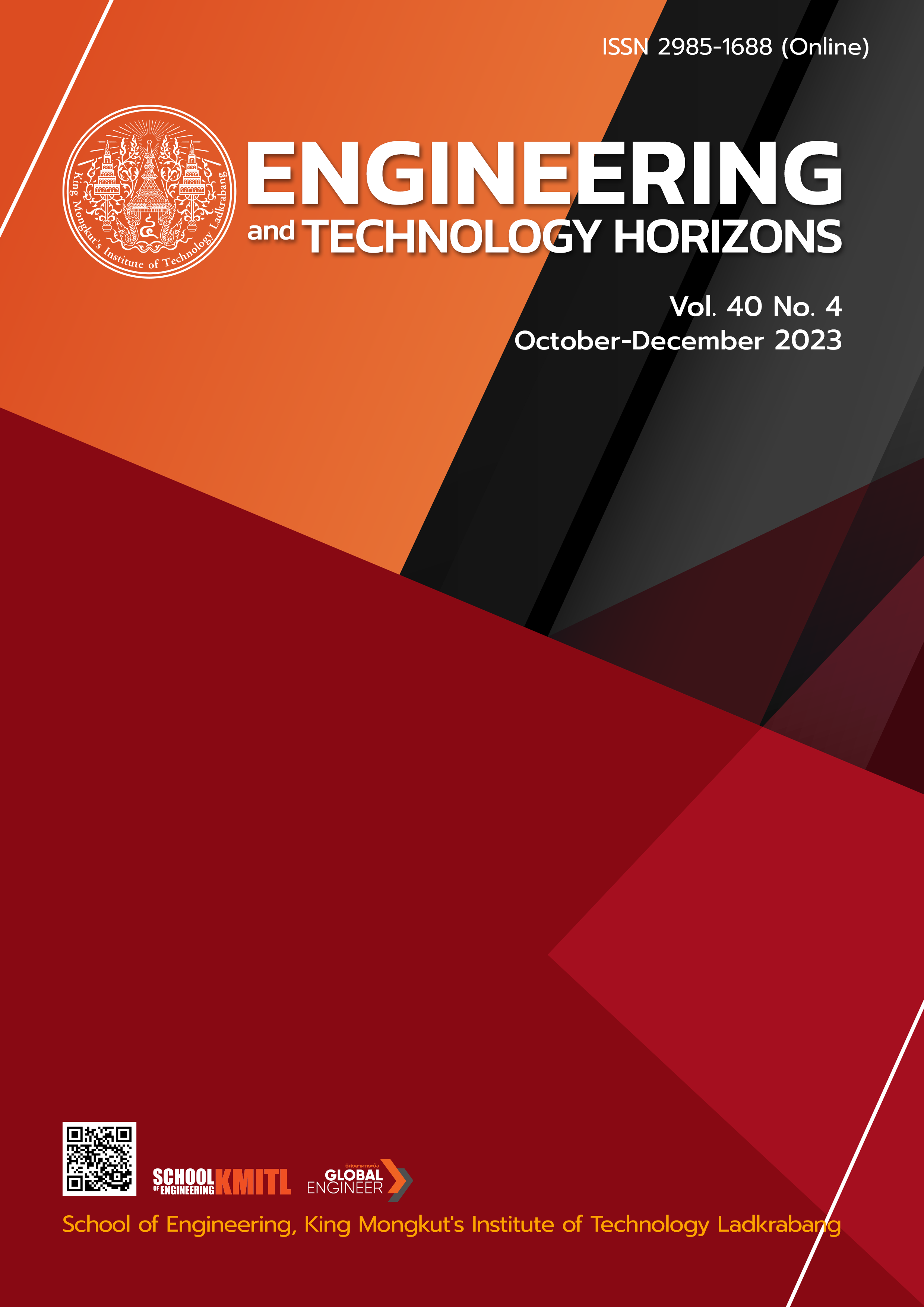Reducing Model Changeover Times in the Metal Packaging Printing Process: A Case Study
DOI:
https://doi.org/10.55003/ETH.400405Keywords:
Model changeover, Metal packaging, Single minute exchange of die, ECRS principleAbstract
The objective of this research is to decrease the duration of model changeover times in the metal package printing process. The study involved the collection of data on the changeover times of the LP7 offset printer model, followed by the utilization of flow process charts to examine four different activities: Feeder, Printer, Coater, and Stacker. It was discovered that certain procedures experienced delays and exhibited prolonged durations. Hence, this study proposed guidelines for improvement aimed at minimizing the duration required for model alteration through the application of the Single Minute Exchange of Die (SMED) principle, achieved by transitioning internal tasks to external tasks. The application of the ECRS method involved the creation of an additional equipment to scoop ink, the use of ink duct foils to cover an ink plate, the rearrangement of work sequences, and the set of pallet shelves. The results indicated that there was a decrease in changeover times in the Printer activity, from 221.26 minutes to 167.26 minutes, resulting in a reduction of 24.41%. Similarly, in the Coater activity, the changeover times decreased from 79.45 minutes to 49.45 minutes, representing a decrease of 37.76%. Additionally, in the Stacker activity, the changeover times decreased from 55 minutes to 30 minutes, representing a reduction of 45.45% compared to the previous duration.
References
B. Silva and M. G. Filho, “Single-minute exchange of die (SMED): a state-of-the-art literature review,” International Journal of Advanced Manufacturing Technology, vol. 102, pp. 4289–4307, 2019, doi: 10.1007/s00170-019-03484-w.
R. B. Ribeiro, J. D. Souza, A. Beluco, L. V. Biehl, J. L. B. Medeiros, F. Sporket, E. G. Rossini and F. A. D. D. Amaral, “Application of the single-minute exchange of die system to the CNC sector of a shoe mold company,” Cogent Engineering, vol. 6, no. 1, pp. 1–11, 2019, doi: 10.1080/23311916.2019.1606376.
M. N. C. Ani and M. S. S. Shafei, “The effectiveness of the single minute exchange of die (SMED) technique for the productivity improvement,” Applied Mechanics and Materials, vol. 465–466, pp. 1144–1148, 2014, doi: 10.4028/www.scientific.net/AMM.465-466.1144.
A. Silva, J. C. Sá, G. Santos, F. J. G. Silva, L. P. Ferreira and M. T. Pereira, “Implementation of SMED in a cutting line,” Procedia Manufacturing, vol. 51, pp. 1355–1362, 2020, doi:10.1016/j.promfg.2020.10.189.
R. Gavali, S. Chavan and G. G. Dongre, “Set-up time reduction of a manufacturing line using SMED technique,” International Research Journal of Engineering and Technology, vol. 3, no. 7, pp. 1748–1750, 2016.
K. Chokpaiboon and T. Kiatcharoenpol, “Reduction of machine set-up time of printing process by using lean technique,” in Proc. National Conference of Industrial Engineering Network, Phetchaburi, Thailand, Oct. 17–19, 2012, pp. 261–265.
M. Sugarindra, M. Ikhwan and M. R. Suryoputro, “Single minute exchange of dies as the solution on setup processes optimization by decreasing changeover time, a case study in automotive part industry,” IOP Conference Series: Materials Science and Engineering, vol. 598, 2019, Art. no. 012026, doi: 10.1088/1757-899X/598/1/012026.
B. M. Deros, D. Mohamad, M. H. M. Idris, M. N. A. Rahman, J. A. Ghani and A. R. Ismail, “Setup time reduction in an automotive battery assembly line,” Applied Science and Engineering Progress, vol. 4, no. 2, pp. 9–13, 2011.
H. Kedziora and J. Trojanowska, “Application of single minute exchange of die tool in a food industry company to eliminate waste,” MATEC Web of Conferences, vol. 343, 2021, Art. no. 02007, doi: 10.1051/matecconf/202134302007.
H. Kelendar and M. Mohammed, “Lean and the ECRS principle: developing a framework to minimise waste in healthcare sectors,” International Journal of Public Health and Clinical Sciences, vol. 7, no. 3, pp. 98–110, 2020.
D. Sindhuja, N. G. Mohandas and P. Madhumathi, “Redesigning of horn assembly line using ECRS principles,” International Journal of Engineering and Innovative Technology, vol. 1, no. 3, pp. 214–217, 2012.
C. Kasemset, P. Pinmanee and P. Umarin, “Application of ECRS and simulation techniques in bottleneck identification and improvement: a paper package factory,” in Proc. Asia Pacific Industrial Engineering and Management Systems Conference, Jeju, Korea, Oct. 12–15, 2014, pp. 1477–1484.
M. Kittiyankajon, “Waste Reduction of Roasted Peanuts Packing Production Line: An Application of Line Balancing and ECRS Techniques,” Journal of Engineering and Innovation, vol. 15, no. 1, pp. 11–22, 2022.
V. Phakphonhamin, “Research kaizen of standardized work analysis with motion study by time prism software (case study: textile industry),” TNI Journal of Engineering and Technology, vol. 7, no. 1, pp. 65–72, 2019.
T. Heebgaew and A. SomSud, “Machine Setup Time Reduction to Increase the Efficiency in Production,” in Proc. National Conference of Industrial Engineering Network, Ubon Ratchathani, Thailand, Jul. 23–26, 2018, pp. 1015–1020.
T. Rattanakool, K. Pochana, T. Ratanawilai and K. Sukkajang, “Setup Time Reducing of Off-Set Printing Machine in Dispenser Box Plant,” in Proc. National Conference of Industrial Engineering Network, Phetchaburi, Thailand, Oct. 17–19, 2012., pp. 440–445.
Downloads
Published
How to Cite
Issue
Section
License
Copyright (c) 2023 Faculty of Engineering, King Mongkut’s Institute of Technology Ladkrabang

This work is licensed under a Creative Commons Attribution-NonCommercial-NoDerivatives 4.0 International License.
The published articles are copyrighted by the School of Engineering, King Mongkut's Institute of Technology Ladkrabang.
The statements contained in each article in this academic journal are the personal opinions of each author and are not related to King Mongkut's Institute of Technology Ladkrabang and other faculty members in the institute.
Responsibility for all elements of each article belongs to each author; If there are any mistakes, each author is solely responsible for his own articles.






